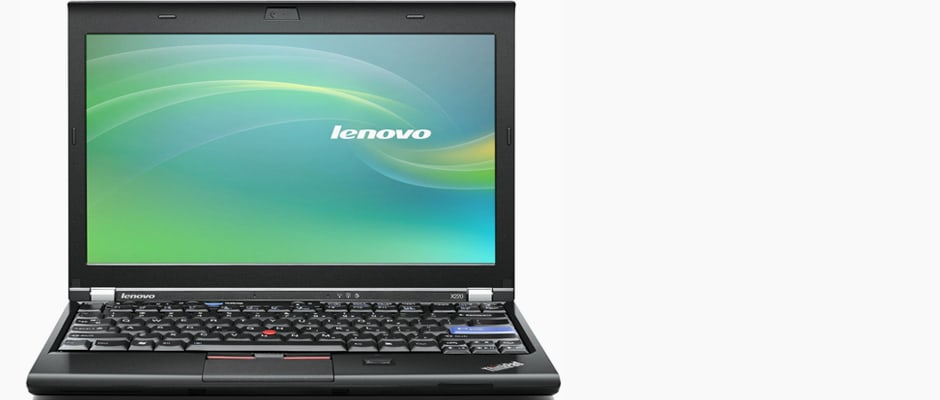Pros
Cons
Overview
Design & Usability
The Lenovo X220 is a textbook example of utilitarian design.
The keyboard on the Lenovo X220 is cramped, designed to prevent crumbs and dust from getting under the keys. This caused a good deal of frustration while typing. Lenovo stuck with its classic seven-tier layout, so veterans of the ThinkPad will have no problem using this keyboard, but there will be a slight learning curve for everyone else.
The majority of the keys have a secondary––and in some cases tertiary––function. All secondary functions are labeled clearly in blue, but good luck deciphering the labels. Though most of the symbols are intuitive, a few required experimentation or––for the more patient among us––a glance at the manual. The cramped nature of the keyboard is offset by its efficient layout. At the touch of two buttons, the user can connect to a projector, change the power settings, and much more.
The laptop has multitouch gestures, too, but some are temperamental at the best of times. For example, spreading your index and middle finger will cause the display to zoom in—at least, that's the theory. In practice, this feature only worked if the spreading motion was parallel with the touchpad. Anytime we had our hands at a natural angle, the gesture’s success was sporadic. The scroll gesture of placing two fingers on the pad and moving up or down––as you would with a current generation Macbook touchpad––was overly sensitive. The touchpad is so compact that even the smallest movement covers a large portion of the pad. This causes the screen to jerk to the beginning or end of the page when scrolling. Should you find the touchpad too frustrating, there is the option to use the built-in pointing stick. It can be set to take over the scrolling with buttons to facilitate clicking.
{{photo_gallery "design"}}
Performance & Features
The X220 is all business, yet testing still proved hit-or-miss at times.
The X220 has a 12.5-inch screen, and the display boasts an IPS panel for a wider viewing angle of the 1366 x 768-pixel screen. The model that we tested carried an i3-2350M Intel processor. However, i5-2520M, i5-2540M, or i7-2640M processors are available for installation––at an extra cost, of course. All models come with a 320 GB hard drive that runs on 4 GB of memory. The X220 also comes with an Intel HD Graphics 3000 processor with dynamic frequency.
For a laptop that's suppose to be all about business, the X220 didn't do so well in our applications testing. Most surprisingly, it scored the lowest of any laptop we've tested thus far in the Excel testing. However, it did very well compressing HD video in our Handbrake test. We're not entirely sure what to make of these results. The data is there; it's up to you decide what you want out of your laptop. In our number crushing test, we used Geekbench, a program that puts laptops through the wringer by making them do complex calculations. In this test, the X220 scored a respectable 5883.
Lasty, the X220's battery life was nothing special. Depending on your settings, you can probably get about three hours of work out of your X220. If you want to burn the midnight oil, you'll have to buy the battery slice, the 6-cell extended battery, or find an outlet.
Conclusion
A fine option for anyone in need of a secondary machine
The Thinkpad we tested housed an Intel Core i3-2350M processor with 4 GB of RAM and 320 GB of storage. It's one of the smallest laptops we've tested, with a travel weight of just 63.3 ounces. Everything on the X220 lends itself to efficiency. It takes up no more space than is needed. The exterior design screams portability, from the textured casing, to the neat handle design on the battery. The engineers at Lenovo wanted the Thinkpad to be compact, and it is, but there have been concessions to achieve this end.
The touchpad is tiny, for instance, and while it accepts multitouch gestures, none of them work reliably. The X220 is expensive, too. It was originally priced at $1,499, though that price dropped in recent months. It's a solid machine in the same way an igneous rock is solid. If we had to recommend this laptop, it'd be as a supplement computer. Its average battery life doesn't allow it to go on really long trips. Small but with large storage capacity, it'd be good as a courier going to off-site locations and gathering data to return to a home base.
Introduction
A sturdy machine to withstand some wear and tear.
Number Crunching
A satisfactory score
Having a computer calculate the digits of pi, sort lists, and foil binomials is a good way to test processing power. Though purely theoretical, Geekbench offers a good gauntlet of conundrums for the Thinkpad to solve. This Lenovo managed a respectable score of 5883.
PC Mark
Heavy lifting not recommended
PC Mark is a series of simulated tests including: video playback, image manipulation, and web browsing. Being completely automated, it's a good standardized test. This laptop scored a 2376 on our PCMark test. That's a fairly low score. It scored over a thousand points lower than its sister, the U300.
Meet the tester
Richard Baguley is a veteran writer who has written about technology ranging from Alphabet to Zip file utilities. He has contributed to pretty much every major tech publication, including Amiga Format Magazine, PC World, Wired, CNET, Toms Guide, Forbes, and many others. He lives in the Boston metro area with his wife, dog, and an indeterminate number of cats.
Checking our work.
Our team is here to help you buy the best stuff and love what you own. Our writers, editors, and experts obsess over the products we cover to make sure you're confident and satisfied. Have a different opinion about something we recommend? Email us and we'll compare notes.
Shoot us an email

